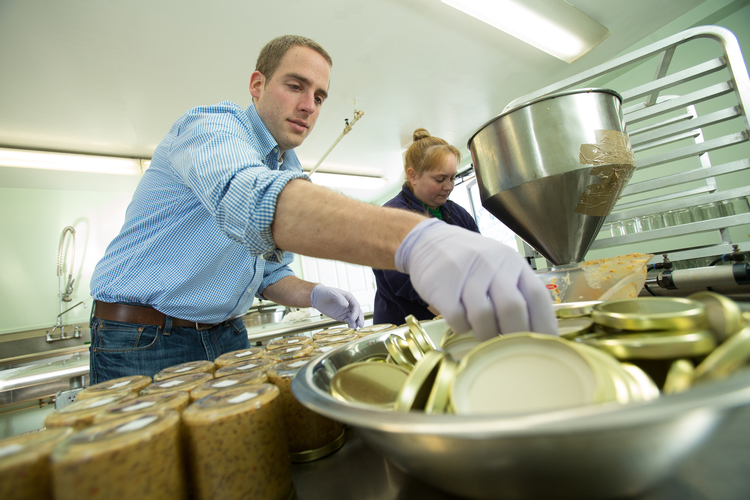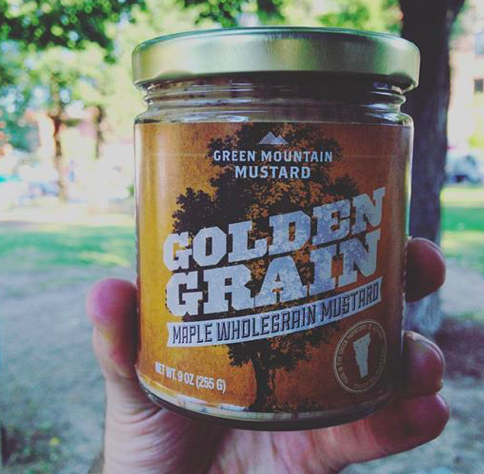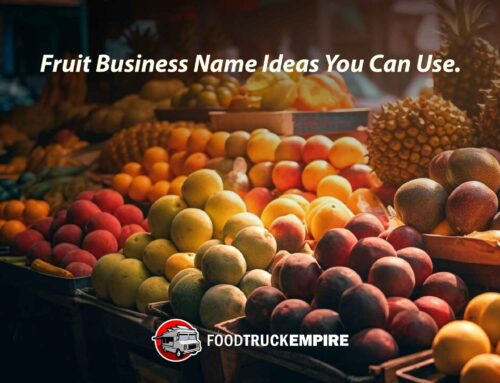Making the switch to a different co-packer or food manufacturer? This is not a decision to make on a whim after a bad. Only after careful consideration of the pros / cons and careful planning should you make this pivotal change.
Have you been having trouble with your current co-packer? Do you keep running into problems you wish would just never happen again? Before you get too deep into this post, I want to make sure you know that this is just one chapter of The Complete Guide to Profitable Co-Packing.
Then maybe it’s time you start the search for a new co-packer. Here’s my personal story on why I switched co-packers. It comes down to three main reasons:

Yes… that’s really me on the production floor bottling mustard.
1. Cost
It was too expensive. My cost of goods sold was upwards of 70%. That meant no room for operating expenses like marketing and running my online store. This was mainly due to the fact we hadn’t quite figured out ingredient costs and we over ordered everything.
Plus, we were charged a flat day rate, driving our per unit cost through the roof. Not to mention the copacker was an hour away. That’s a lot of time and money I was wasting.
2. Size of Business
My first food manufacturer was simply too big for my business. I was fresh out of college, some money in the bank, and a successful energy bar company. Now, I wanted to get my mustard company off the ground. The $10,000 I had in my bank account was gone in a matter of months. Why?
Well, to make everything cost effective, we had to produce 1,000 – 1,200 units a day. Often times, production spilled over into the next day, too.
Every production run cost me several thousand dollars. This taught me I needed to find a smaller operation that produced closer to demand for my product. Somewhere I could produce a couple hundred units to sell at farmer’s markets and a few area retailers.
3. Relationship

My top selling whole grain mustard.
I just don’t think we got along the way I would have liked to. I felt my interests weren’t addressed and my first copacker was focused on larger clients. Clients who produced thousands of units several days a week. We were small potatoes. Plus, the error that was made with the horseradish powder (see above) didn’t sit right with me. I wasn’t consulted when something went wrong several times. And losing trust with your co-packer is a position you never want to be in.
Related Reading: The Hidden Costs of Working with a Co-Packer Revealed.
Your reasons to switch co-packers may be different than mine. You may have simply outgrown your copacker’s kitchen or moved your entire operation to the west coast. Whatever the reason, if you’re thinking about switching to a new co-packer, make the process as smooth as possible.
How to make a smooth transition to your new co-packer
1. Tie up loose ends with your current co-packer

Tie up those loose ends.
You may be in a contract with your co-packer. This would prevent you from leaving, unless there’s a stipulation in the contract to cut ties earlier. Regardless, schedule your final production with your copacker. Make arrangements to get ingredients and anything else in storage out and to the new location. This may mean storing things in your house or a storage locker in between productions.
It’s important to leave cordially and on good terms. Explain to your co-packer why you’re leaving and that you wish them well. It’s likely there aren’t many co-packers to choose from in your area. Don’t burn bridges!
2. Have recipes (with process) read for your new co-packer
When you move to a new copacker, get a nondisclosure agreement signed and then send your recipes over. But, don’t throw them into unknown territory.
Include your scheduled process, ingredient list, and how to make the product. Does it sit overnight? Is it heated to a certain temperature? Do you want your labels put on a certain way? Your new co-packer won’t know anything of this if you haven’t told them.
3. New kitchen. New process.

Food Manufacturing Facility.
From ingredient storage to selecting kitchen dates, and shipping purchase orders, it could all be different from your old manufacturer. Be patient as you figure everything out. Your new kitchen manager should orient you to the new space, but there’s still going to be a few lessons learned a couple months in. If you’re accommodating and relaxed, your co-packer will be, too. And that means they’ll produce highquality product for you.
You don’t have to pull your hair out just to switch co-packers. It can be a quick and easy process if you follow these tips.
Plus, the switch should make things easier on your cashflow (unless you’re upgrading). And when you’re in better shape financially you can focus on growing your business. Did someone say regional brand?
Switching co-packers doesn’t come without its bumps along the way. Stay patient as you work with your new kitchen manager to make the transition.
So, what’s next?
What’s your company look like after you’ve settled in with your new co-packer? Hopefully it’s a lot more stress free and you’re able to relax just a bit.
With that, this guide is coming to an end. Thanks for reading all the way down to the end. I really appreciate it. If you still have questions about starting a food product business, refer to this FAQ post for answers.
To continue the learning, I invite you to sign up for the Food Business Startup Kit. I’ve included a whole bunch of templates needed to start a food business and recorded a special audio lesson just for you. You’ll also get access our intimate community of food entrepreneurs where we discuss all sorts of food business trends.
I wish you success on your new food business. And don’t forget to have some fun along the way too!




